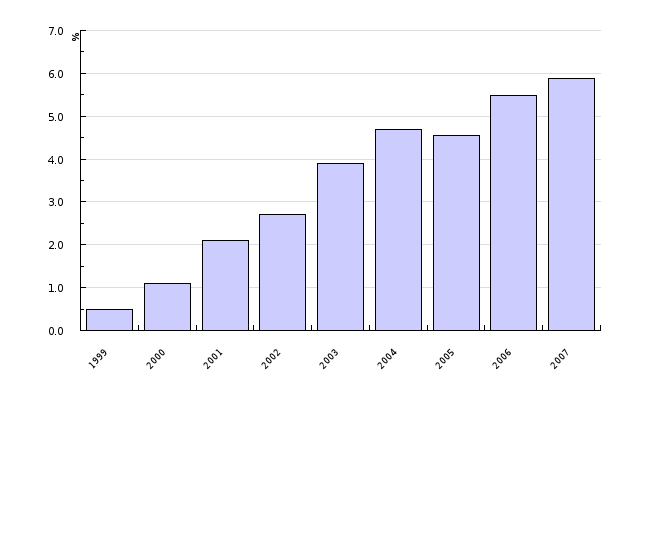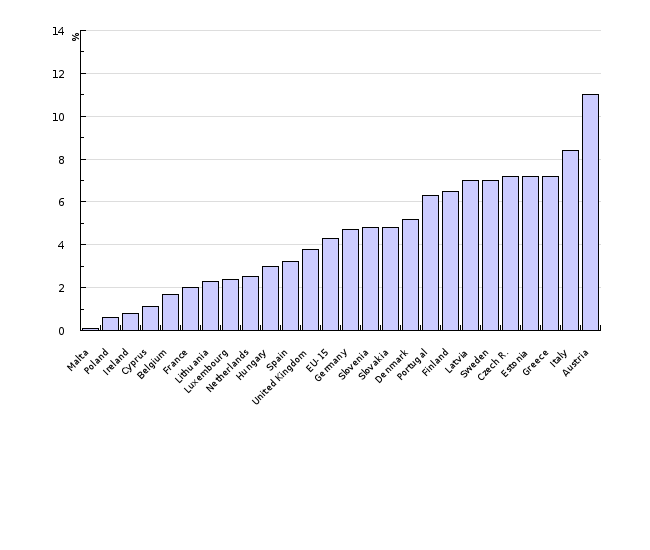[KM08] Area under organic farming

Key message

In 2004, area devoted to organic farming (sum of organic and in-conversion area) covered 23,023 ha, which is almost ten times more than in the first year of the implementation of this agri-environmental measure (2,400 ha in 1999). The share of organic farming area in the total utilised agricultural area increased from 0.5 % in 1999 to 4.7 % in 2004.
Definition
The indicator presents area under organic farming. It comprises area where organic farming is already implemented and area in the process of conversion into organic production. The relative indicator is the share of organic farming area in the total utilised agricultural area. The indicator does not provide direct information on the environmental efficiency of the measure; rather, it indicates the reaction of agricultural holdings to the agricultural policy supporting this type of production.
Charts
Analiza stanja ekološkega kmetijstva v Sloveniji, MKGP, 1999-2007; Pridelki in površina, SURS, 1999-2007
| 1999 | 2000 | 2001 | 2002 | 2003 | 2004 | 2005 | 2006 | 2007 | ||
|---|---|---|---|---|---|---|---|---|---|---|
| Organic farming area | ha | 2400 | 5446 | 10828 | 13828 | 20018 | 23019 | 23169 | 26831 | 29322 |
| Permanent grassland | ha | - | - | 10000 | 12800 | 18500 | 20908 | 21670 | 24458 | 25796 |
| Arable land | ha | - | - | 721 | 908 | 1368 | 1722 | 1066 | 1684 | 2652 |
| Vineyards | ha | - | - | 52 | 55 | 50 | 49 | 67 | 125 | 184 |
| Olive growes | ha | - | - | - | - | - | 4 | 6 | 28 | 21 |
| Orchards | ha | - | - | 55 | 65 | 100 | 336 | 360 | 536 | 669 |
| Utilised agricultural area (UAA), total | ha | 498591 | 508960 | 509624 | 505462 | 509709 | 490518 | 508759 | 490341 | 498577 |
| Share of organic farming area in total UAA | % | 0.5 | 1.1 | 2.1 | 2.7 | 3.9 | 4.7 | 4.6 | 5.5 | 5.9 |
Area under organic farming, EUROSTAT portal.
| Malta | Poland | Ireland | Cyprus | Belgium | France | Lithuania | Luxembourg | Netherlands | Hungary | ||
|---|---|---|---|---|---|---|---|---|---|---|---|
| 2005 | % | 0.1 | 0.6 | 0.8 | 1.1 | 1.7 | 2 | 2.3 | 2.4 | 2.5 | 3 |
| Spain | United Kingdom | EU-15 | Germany | Slovenia | Slovakia | Denmark | Portugal | Finland | Latvia | ||
| 2005 | % | 3.2 | 3.8 | 4.3 | 4.7 | 4.8 | 4.8 | 5.2 | 6.3 | 6.5 | 7 |
| Sweden | Czech R. | Estonia | Greece | Italy | Austria | ||||||
| 2005 | % | 7 | 7.2 | 7.2 | 7.2 | 8.4 | 11 |
Goals
The organic farming contribute to the production of better quality food, protection of the environment, and conservation of biodiversity. The Rural Development Programme of the Republic of Slovenia 2004–2006 (Official Gazette RS No. 116/2004), has set a target of 5 % of utilised agricultural area under organic farming by 2006 while according to the Action Plan for Development of Organic Agriculture in Slovenia (Government of the Republic of Slovenia, 24 November 2005) the targets for organic farming are 15 % of agricultural holdings or 20 % of utilised agricultural area by 2015.
Comment
In Slovenia, organic farming started to spread in late 1990’s, and farmers could obtain the first support for this type of the production in 1999. Up to 2000, organic farming was governed by the Recommendations for Organic Farming (MAFF, 1997) or adopted guidelines of organic societies and associations coordinated with principal standards of the International Federation of Organic Agriculture Movements. From 2001 on, organic farming has been one of the measure of the Slovenian Agri-Environmental Programme (Official Gazette RS, No. 34/01), which, after Slovenia’s entrance in the EU, became part of the Rural Development Programme 2004–2006 (Official Gazette RS, No. 116/04). Organic farming is carried out on the basis of the Rules on Organic Production and Processing of Agricultural Products and Food (Official Gazette RS, No 31/01, 52/03), coordinated with the Council Regulation (EC) 2092/91 on organic production of agricultural products or foodstuffs. The Rules set in this framework require farmers to fulfil the standards (production methods), and determine the certification procedures (compulsory inspection) and a specific labelling scheme. On land intended for organic production, it is forbidden to use synthetic pesticides and readily soluble mineral fertilizers, growth regulators and promoters, genetically modified organisms, etc. . Special brand names are used for labelling organic products, which in addition to certificates issued by the official control organisation, guarantee the consumers that the production was in accordance with the organic farming guidelines.
Organic farming got a favourable response from the producers and consumers alike, which is evident from the increase of area under organic farming. In 1999, organic production area (and in-conversion area) covered 2,400 ha, in 2001 10,828 ha, and in 2004 it covered 23,023 ha. In 2004, the share of organic farming in the total utilised agricultural area was 4.7 %, while in 1999 it was only 0.5 %. In spite of the increased area, organic farming is still modest in comparison with the conventional production.
In 2002, organic farming (or the process of conversion into organic farming) in the EU-15 took place on 3.8 % of total utilised agricultural area (1.7 % in 1998). There are considerable differences among individual countries. In 2002, the following countries exceeded the EU-15 average share of organic farming area: Austria (9 %), Italy (8 %), Finland in Sweden (7 %), Denmark (6 %), Great Britain (5 %) and Germany (4 %).
Methodology
Data for Slovenia
Data on area are taken from the register of organic farms with the Ministry of Agriculture, Forestry and Food (MAFF). The source of data on the total utilised agricultural area (UAA) for the calculation of the relative indicator is the Statistical Office of the Republic of Slovenia (SORS). Data are updated on an annual basis. The indicator is fully coordinated with the indicator for the EU-15. Data by municipalities were acquired from the Agency of the Republic of Slovenia for Agricultural Markets and Rural Development (ARSAMRD) database where only area for which area-based payments for organic farming were granted is included (without in-conversion area).
Data for other countries
– Name of original database: IRENA Indicator Fact Sheet; IRENA 07: Area under organic farming
– Trustee Institution: EEA/IRENA with DG AGRI
Original data were acquired by the Organic farming questionnaire on Regulation (EEC) No 2092/91, sent to Eurostat by the EU-15 member countries on a yearly basis, but published with considerable delay. Data includes organic farming and in-conversion area.










